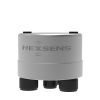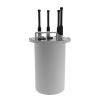ANB Sensors OC-Series Calibration-Free pH Sensors
Features
- Patented technology automatically calibrates in-situ without need for manual intervention
- Can be deployed autonomously or fit on any vehicle, sonde or monitoring platform
- Sensor can be stored wet or dry without any degradation of performance
- Expedited repair and warranty service
- Lifetime technical support
- More
ANB Sensors has developed ground-breaking solid-state sensors for pH, conductivity & temperature. These innovative and revolutionary sensors, require no calibration, operate to depths of 50 meters in any orientation in fresh or saltwater environments.
Uniquely, they can be stored wet or dry, require simple maintenance, are extremely rugged and have exceptionally low on-going costs ideally suited for long term, cost effective remote monitoring in harsh and demanding environments. Thus, removing the fundamental issues seen with the conventional, fragile glass electrodes which require frequent manual calibration.
Calibration-Free: Unlike other pH sensors that need frequent re-calibration, ANB’s patented technology means that the sensor is automatically calibrated in-situ without the need for manual intervention.
Adaptable: These calibration-free pH sensors can be deployed autonomously or fit on any vehicle, sonde or monitoring platform.
Robust & Reliable: These solid-state sensors can be stored wet or dry without any degradation of performance, have no special handling requirements and operate in any orientation, delivering consistent & reliable performance in demanding environments.
Affordable: Being cost-effective and extremely low maintenance, these revolutionary sensors deliver up to 70% savings against operating costs of conventional sensors.
Intelligent: Constantly monitoring themselves these sensors provide real time feedback on sensor performance, continuously self-calibrating and automatically notifying an operator should user intervention be required.
Choice: 2 models are available for operating at different depths and applications, choose from sensors designed to operate up to 300m & 1250m depths.
Flexible: Automated operation for schedule and sample frequency plus manual command and sleep mode, data can be accessed via RS232 or RS485 communications, with analogue connectivity scheduled for future implementation.
Storage: Onboard 8GB memory allows storage of >15 million sensor readings of pH, conductivity, and temperature.
Biofouling: These sensors are designed to stop biofouling as standard, by electrochemically inhibiting the formation of biofilm on the transducer.
- Range: 2 – 10 pH
- Resolution: 0.01 pH
- Accuracy: +/- 0.05 pH
- Response: Instantaneous
- Salinity Range: 0 – 40 ppt
- Temperature Resolution: 0.1C
- Operational Temperature: -5 - 40°C
- Communications: RS232 / RS485 / USB
- Power: 5 – 42 VDC
- Power Consumption: 90 mA
- Sleep Mode Consumption: <1 mA
- Operational Modes: timed / polled / continuous
- Onboard Storage: 8GB
- Dimensions: 191mm long x 41mm Ø
- OC300 Weight: 0.30Kg (air) 0.08Kg (water)
- AQ50 Weight: 0.60Kg (air) 0.38Kg (water)
- OC-Series Calibration-Free pH Sensor
- MCIL-6-FS Cable with Locking Sleeve, 1m
- DTU Data Transfer Unit
In The News
Sargassum Surge: How Seaweed is Transforming our Oceans and Coastal Ecosystems
Until recently, Sargassum –a free-floating seaweed–was distributed throughout the Sargasso Sea , the north Caribbean Sea, and the Gulf of Mexico. But in the space of a decade, this seaweed has, as one scientist remarks , “Gone from a nonfactor to the source of a terrible crisis.” Driven by climate change, anomalous North Atlantic Oscillation in 2009-2010 and a glut of anthropogenic pollutants, sargassum has proliferated. Seasonally recurrent mats as deep as 7m now bloom in the “Great Atlantic Sargassum Belt” (GASB), which covers areas of the Atlantic from West Africa to the Caribbean Sea and Gulf of Mexico. Every year, millions of tons wash up along the shores of more than 30 countries . Dr.
Read MoreGreat Lakes Research Center: Designing Targeted Monitoring Solutions
According to the National Oceanic and Atmospheric Administration ( NOAA ), the Great Lakes have more miles of coastline than the contiguous Atlantic and Pacific coasts combined and contain 20 percent of the world's freshwater, making it a critical region to protect and conserve. Continuous monitoring and data-informed resource management are key components of managing waters in the region. Hayden Henderson, a research engineer with the Great Lakes Research Center (GLRC), designs and deploys monitoring platforms throughout the Great Lakes. With a background in environmental engineering, Henderson enjoyed the challenge of creating systems and making them work to obtain difficult, remote measurements.
Read MoreMonitoring Meadowbrook Creek: Real-Time Data Collection in an Urban Creek
Meadowbrook Creek in Syracuse, New York, has been monitored by Syracuse University (SU) faculty and students for over a decade. Originally established by Dr. Laura Lautz in 2012, the early years of the program focused on collecting grab water samples for laboratory analysis and evaluating the impact of urban land use, human activities, and natural processes on water resources. Tao Wen , an Assistant Professor in SU’s Department of Earth and Environmental Sciences, took over the program in 2020 and upgraded the existing systems to include 4G modems that allowed for real-time data viewing. [caption id="attachment_39339" align="alignnone" width="940"] An overview of the Fellows Ave monitoring station along Meadowbrook Creek.
Read More

















